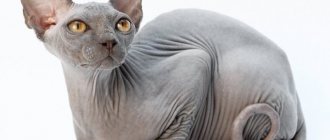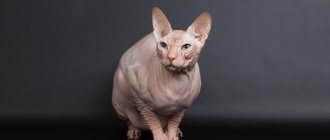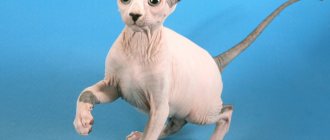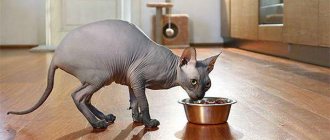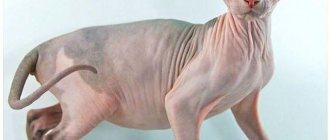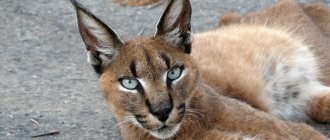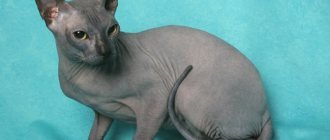Don Sphynxes are hairless cats with large ears, folded skin and a distant look. Their pretentious appearance makes a lasting impression.
A good-natured and gentle disposition, as well as affection for the owner, make these animals real couch physiotherapists. To make life with a Donchak comfortable for both the cat and the owner, you need to understand the specifics of the breed.
Brief history of the breed
The small homeland of these hairless cats is Rostov-on-Don.
In the late 1980s, city resident Elena Kovaleva picked up a stray cat. The woman named the foundling Varvara and treated her for baldness for a long time. When it became clear that the therapy was not bringing results, it was decided to leave the cat alone.
Having matured, Varvara gave birth to babies from the local cat Vasily. One girl from the litter turned out to be as hairless as her mother. The unusual cat was named Chita and began to be used for breeding purposes.
In 1992, an experimental breed standard was created. In 1997, the Donetsk team received recognition from the WCF. Today, the Rostov Sphinx is recognized by all major felinological organizations.
History of the origin of the Don Sphinx
Russia is recognized as the country of origin of the breed. It was here in the winter of 1986 that a resident of the Rostov region saved a stray kitten from the hands of hooligans.
The rescued animal turned out to be a girl. The owner called her Varvara and began to nurse her. Despite the care, the cat soon began to go bald on her back. She was taken to doctors, but they just threw up their hands. Judging by the tests, the animal was absolutely healthy.
Only 2 years later, Varvara, with the pitiful remains of her former fur coat, was examined by felinologists, but did not make an impression on them. She was noticed only in 1990, when, after mating with a shorthaired European cat, she gave birth to one practically hairless kitten. The baby, named Chita, interested the breeder Irina Nemykina. The woman took the future founder of the breed with her and began breeding experiments.
Chita was balder than Varvara, but some hair was present on her paws and tail. Subsequent matings with short-haired partners did not give the desired results. The fur did not disappear. Then Nemykina decided to resort to inbreeding, that is, mating close relatives.
Her efforts paid off. The first completely hairless kitten was a baby named Basya Mif. In 1996, hairless wards received official recognition and their name.
Due to the small number of Donchaks, until 2000 they continued to be bred with European Shorthairs, Russian Blues, Siamese and Angoras. One of these experiments led to the formation of another breed - the Peterbald.
Varieties
Depending on the type and structure of the coat, representatives of the Don Sphynx breed are divided into types:
- velor: at birth, such cats are covered with hair 2-3 mm long. As they grow older, the hairs fall out, completely exposing the skin;
- Brush: The body of these Don Chaks is covered with long, hard, curly hair. Usually, by the age of two years, Don Sphynxes of this type become completely or partially bald;
- flock: A cat's skin is covered with fine, short hair that looks more like down. Over time, the hair falls out;
- hairless (“rubber”): these Don Sphynxes are born completely hairless, and their bodies are covered with hot, wrinkled skin.
On a note. Donchak dogs with brushed wool are not allowed for exhibitions, but are quite suitable for breeding.
In turn, the velor sphinx type has varieties:
- light velor - with wool no longer than 2 mm;
- velor point - with short pile on the paws and muzzle up to 4 mm long;
- downy velor - with soft fur all over the body.
Brash Don Sphynxes are also divided into:
- brush velor: with hair no longer than 0.5 cm. As the cat gets older, the cover changes to a thin flock in the neck, back and sides;
- brush point: at birth, babies have thick fur. By the age of one and a half years, the cover of such Donchak becomes thinner. The tail and muzzle of the sphinx are overgrown with short, thick hair. The remaining parts of the cat's body are covered with light velor;
- dense brush: with thick hair, under which the Donchak skin is not visible.
Nutrition
The lack of fur (and, therefore, warmth) is compensated for by sphinxes with accelerated metabolism and increased activity. Therefore, food for them should be higher in calories and more plentiful. But Don Chaks also do not have moderation in food, so their diet must be strictly monitored: they are not allowed more than 200–250 g of natural food (the amount of food is calculated according to the instructions on the package).
Natural type of nutrition
What can the Don Sphynxes do:
- meat (beef, poultry, lamb, rabbit) and offal (liver, heart, lung, udder). You can use chicken necks, heads, hearts, liver) - 65%;
- fish (exclusively sea and boiled) - 2 times a week, no more than 20-40 g at a time;
- eggs (chicken, quail) - 2-3 times a week;
- vegetables, herbs, sprouted oats - 5–10%;
- grain crops (all types of cereals are allowed) - approx. 15–20%;
- dairy products (milk, sour cream, cottage cheese, kefir, hard and low-fat cheese, curdled milk and others) - 5%;
- soups (broths) - as an addition to cereals.
What Don Sphynxes cannot do:
- raw river fish;
- bones (tubular bird, rabbit and fish);
- fatty pork or poultry meat and lard;
- smoked, salted and spicy products;
- sweets and baked goods;
- dog food, it does not meet the needs of the cat;
- onion products and those containing chocolate, as they can have a toxic effect on the cat;
- leftover food from its table, because the animal gets used to choosing food and refuses its usual food.
Eating food
The following foods are suitable for Donchak:
- Orijen Cat & Kitten (Canada) - holistic food.
- ACANA Grasslands for Cats (Canada) – holistic food.
- Purina Pro Plan Delicate (France) – super premium.
- Royal Canin Sphynx Adult (USA, France) – premium class.
- Hill's Science Plan Adult Lamb (USA) – premium.
Kittens can be offered:
- Royal Canin Babycat Instinctive - mousse for kittens up to 4 months;
- Royal Canin Kitten - dry food for kittens from 4 to 12 months;
- Purina Pro Plan Junior Chicken - canned food for kittens with chicken;
- Wahre Liebe “Junge” – dry food for kittens with colostrum;
- Hills Cat Science Plan Kitten Tuna - dry food for kittens with tuna;
- GO! Sensitivity + Shine Duck Cat Recipe Limited Ingredient Diet, Grain Free - for kittens and cats with sensitive digestion;
- Orijen Cat & Kitten (Canada) - holistic food;
- ACANA Grasslands for Cats (Canada) – holistic food.
If your cat has sensitive digestion, then the following will suit her:
- GO Sensitivity Shine;
- 1st Choice;
- Gina Elite Cat Sensitive;
- Josera SensiCat;
- Bozita Feline Funktion Sensitive Diet & Stomach;
- Hill's Science Plan Sensitive Stomach;
- Royal Canin Sensible 33.
Interesting Facts
Fans who are not indifferent to the Don Sphynx cat breed discover interesting facts when getting to know her:
- These hairless animals need constant communication with people and do not miss the opportunity to touch them. Because of this feature, they are often called “kissing” cats;
- The skin of Don sphinxes is comparable to human skin. Under the influence of the sun, a tan appears on it, sweat appears in the heat;
- Don Sphynxes were used to develop a new breed called the Peterbald. For this purpose, hairless cats were bred with Turkish Angora, Siamese and Russian Blues.
First days at home
Before buying a kitten, you need to secure the room in which it will live: remove wires and flowers from the windowsill. If you have other animals at home, you should not introduce them on the first day, the pet will be scared.
At the pet store you need to purchase: dishes for feeding (it is better to choose ceramics or stainless steel), a tray, a scratching post, a bed, toys.
In the first days, give the animal as much time as possible. It will take 2-3 days for him to adapt to new living conditions.
Breed description, standards, appearance
The Don Sphynx is a harmonious cat with strong bones and hot, velvety skin. She has a memorable appearance that evokes associations with an alien.
The anatomical characteristics of the Donchak are specified in detail in the breed standard.
Dimensions and weight
The Don Sphynx cat is considered a medium-sized animal. It grows to 25-30 cm at the withers. The weight of an adult female is 3.5-5 kg. The Donchak cat weighs up to 7 kg.
Anatomical characteristics
A typical hairless cat must conform to the official breed description. A real Don Sphynx looks like this:
- the head is wedge-shaped, with a flat forehead, clearly defined cheekbones and developed eyebrows. The nose is straight, the whisker pads are visualized;
- eyes are medium-sized, almond-shaped. The color of the iris depends on the base color;
- The ears are set wide apart and large. The tips are rounded. The external contours do not protrude beyond the cheek line;
- the body is strong, with developed muscles, a straight back and graceful posture;
- limbs are long and thin. The paw pads are oblong. Fingers extended;
- the tail is long, flexible, without bends.
Skin and color
Don Sphynxes have elastic skin that gathers in folds in the groin, armpits and forehead. The skin is almost hot to the touch.
The color of cats without fur on their bodies is determined by skin pigmentation. According to the Donetsk standard, any colors are allowed. Most often found in the breed:
- ginger;
- lilac;
- black;
- blue;
- white;
- red-pink;
- chocolate;
- cream;
- tabby;
- calico;
- smoky (gray).
Possible breed defects
The disadvantages, in the presence of which the Don Sphynxes will not receive a high expert assessment, include:
- Round eyes;
- undershot up to 2 mm;
- short, narrow or round head;
- complete pubescence;
- short or irregularly ending tail;
- low-set or small ears;
- weak, light or shortened body.
Important! Donchak dogs with an inversion of the eyelids or an underbite of more than 2 mm do not participate in exhibitions and are not used for breeding.
Choosing a kitten
First you need to decide why you need a cat. Based on the requirements for the animal, you need to choose a class:
- Show. The best of the best, the most expensive in price. Suitable for exhibitions and breeding. The price of the Show-Don Sphynx is from 30,000 rubles.
- Breed. Full compliance with the standard, but minor defects are possible that do not allow for an exhibition career. however they are suitable for breeding. The price of such a sphinx is from 15,000 to 30,000 rubles.
- Pet. There are disadvantages that do not allow participation in breeding and exhibitions. Sold as pets. Price - from 9,000 to 15,000 rubles.
Kittens are sold no earlier than 4 months of age. How to identify a purebred Don Sphynx:
- Curled whiskers are a mandatory distinguishing feature of newborn Don Sphynxes.
- You can judge by its coat whether the kitten is a representative of the breed (it must meet the standard).
- You should also look at the kitten’s parents and ask for their documents - if they meet the standard and are completely healthy, then the kitten will be a true representative of the breed, healthy and fully developed.
- Pay attention to the kitten's health:
- healthy babies are active and cheerful;
- the kitten should not be scared, should show curiosity and playfulness;
- the eyes do not water, pus does not ooze from the nose and ears;
- there are no wounds or redness on the skin, it is clean and smooth.
Healthy kittens are active and cheerful
Character and temperament
Don Sphynxes are soft and vulnerable cats that require constant communication with humans. They are not prone to aggression and are absolutely not jealous. Good-natured Donetsk people are easy to offend, but difficult to anger.
The gentle, hairless cats love attention and often sit on their owners' laps. At the same time, they are not prone to excessive intrusiveness and will not bother with tenderness to those who do not need them.
Don Sphynxes are moderately lazy animals. They will be equally happy to engage in standard cat activities and spend time sitting comfortably on a warm radiator.
Breed and children
Sociable Don Sphynxes get along well with children of different ages. They never allow themselves to attack children. Donchak people happily take part in funny children's pranks.
Breed and other animals
The character of cats of the Don Sphynx breed is non-conflicting. This allows them to live peacefully in the same territory not only with their relatives and non-aggressive dogs, but also with guinea pigs, parrots and hamsters.
The character of the Don Sphynx
The friendliness of the Donchak cannot be ignored. This cat is hospitable to strangers and does not mind sitting in their arms upon first meeting. He will never scratch or bite his playmate, so you can safely leave him with small children.
Also, a bald pet does not mind playing with other pets. His social circle is not limited even to rodents and birds. Donchak immediately understands that small pets are family members just like him, which means they must be treated with care and love.
The character of the Don Sphynx is moderately lazy. He shows the greatest activity in childhood, and with age he becomes balanced. Despite this, the Donchak will never refuse to play with his beloved owner.
Representatives of this breed have developed intelligence. Their dexterous long fingers skillfully open door locks and kitchen cabinets. Animals are also able to detect the owner’s mood and health problems.
A tame pet never imposes its communication if it sees that a person is busy. But in case of illness, he will definitely lie down on the sore spot and warm it with his warmth, trying to alleviate the condition of the sick person.
How to choose the right kitten
Little Don Sphynxes are fragile and gentle creatures. They are susceptible to various diseases and often die at the age of several weeks. In order not to lose a newly adopted pet, it is advisable to purchase a kitten of this breed no earlier than he is 3 months old.
It is better to buy a Donchak from a specialized nursery or from a trusted breeder. At the time of sale, the Sphynx must have a veterinary passport with vaccination marks and a metric that confirms purebred.
A healthy kitten has a neat appearance and is actively interested in everything that happens around. It is important that he does not have a bloated belly, watery eyes, dirt under his tail, or scratched or flaky skin.
Kitten care
Little Don Sphynx cats are taken from their mother at the age of 12 weeks. By this time, the kittens are already quite independent. They know how to eat, know the scratching post and are litter box trained. Therefore, new Donchak owners just need to give the pet time to get used to the changed conditions and show him places where he can eat, drink, go to the toilet and sharpen his claws.
For safety reasons, wires, indoor plants, household chemicals and small objects are hidden from the baby Sphynx. A curious kitten can climb into the most unexpected places. Therefore, before turning on the washing machine or oven, you should definitely look inside to make sure that there is no curious animal there.
Attitude towards other animals
Don cats are peaceful creatures. The Kuban Sphynx is completely non-conflict, so it will not start quarrels with other pets. The owner’s task is to provide the pet with its own place where it will rest from communicating with other animals with which the hairless cat lives under the same roof. Rostov sphinxes get along well not only with individuals of their own species - the Donchak is able to get along with a dog, and will not hunt the owner’s hamster or guinea pig.
True, the naturally curious Donchak may well “count” the host fish in the aquarium. That's why he's a cat.
Care and maintenance
Don Sphynxes are heat-loving animals that prefer to spend time near heating devices or in the sun. Therefore, cats of this breed should only be kept at home.
Caring for a Donchak is not at all difficult. The main thing is to do this regularly.
Hygiene procedures
The eyes of Don Chaks are not protected by eyelashes and require special care. They are wiped daily with a cotton pad soaked in chamomile infusion or boiled water. If redness or purulent discharge is detected, the Don Sphynx must be shown to a veterinarian.
The cat's ears are wiped twice a week with a cotton swab moistened with a special lotion. This is done very carefully so as not to damage the organ.
Read more about proper hygienic cleaning of the Sphynx's ears and eyes.
The claws of the Don Sphynx are periodically shortened with a claw cutter. The procedure is carried out with utmost care so as not to touch living tissue.
Donchak's teeth are cleaned 2 times a week with a silicone brush with a small amount of special paste for animals.
Skin care
Don Sphynxes sweat, and their skin secretes a protective brown lubricant. That’s why these cats are bathed more often than representatives of other breeds.
Donetsk residents are provided with bathing procedures 1-2 times a month. Wash them using a natural mild or cleansing antibacterial shampoo.
In addition, the skin of hairless cats is wiped daily with a linen or cotton cloth, which is moistened with a caring lotion or boiled water.
On a note. In summer, the Donchak skin is protected from ultraviolet radiation by lubricating it with special creams.
Tray
The Don Sphynx is a clean cat, he quickly gets used to going to the toilet in a designated place. A spacious plastic tray is selected for it, which does not absorb odors.
Any filler can be used. The main thing is that the Donetsk likes him and copes with his functions.
Raising the Don Sphynx
The upbringing of a Donchak begins from the first days of his appearance in the house. At first, the baby may attack his hands, scratch furniture and chew his slippers. This behavior can quickly be eliminated if you understand how to properly raise a cat.
Prevent any unwanted actions with a loud sound (clapping your hands), spraying water or hissing. A sharp noise and suddenly appearing liquid frighten the animal, distracting it from its mischief. Over time, the pet notices the relationship and stops misbehaving.
Full training, including teaching basic commands and simple tricks, is possible, but will require effort. To achieve results, you will have to interest your bald pet. He is capable of a lot, but will not perform any actions without the desire. In this case, a game form of learning works best.
Donchak people quickly understand how to use not only a litter box, but also an ordinary human toilet. Despite the ingenuity, relief from need does not always go smoothly. Even a well-mannered pet can begin to mark its territory. The only plus is that the tags are odorless.
You will have to deal with unwanted behavior using the same techniques, adding oilcloth to the “latrine”. Its specific smell is unpleasant for the cat, so it will quickly forget the way to the restricted area.
Sphynx cats hate grooming. Washing, drying and trimming nails turns into a real test of strength. For more adequate behavior of your pet, try to accustom him to hygiene procedures from early childhood. Otherwise, only a professional groomer can handle it, but the cat’s psyche will still be crippled.
Looking for the Don Sphynx? Find your pet from 1 offer As a gift
Feeding the cat
Don Sphynxes are distinguished by accelerated metabolism and increased heat transfer. Hairless cats require more food to maintain their body temperature than other breeds.
Complete diet
When fed dry food, the Don Sphynx is given premium, super-premium or holistic-class products, which do not contain any questionable components.
The best brands to meet these criteria are RoyalCanin, ProPlan, Hills, Acana and 1st Choice.
When feeding natural products, the menu for Donchak is designed so that lean, fresh meat predominates in it. The sphinx is also given:
- sea fish;
- eggs;
- dairy products;
- porridge with water;
- boiled vegetables.
Don Sphynx dogs should not be offered pork, river fish, bones, sweets, baked goods, smoked meats or sausages. It is forbidden to feed cats of this breed salty, spicy, fried and fatty foods, as well as leftovers from the owner’s plate.
Feeding frequency
Small Don Sphynxes eat less and more often than adult representatives of the breed. Therefore, the diet is made taking into account the age of the cat:
- up to 3 months – 5 times a day;
- 3-6 months – 4 times a day;
- from 6 months – 3 times a day.
Vitamins and minerals
If the Don Sphynx eats natural food, a lack of microelements may occur in its body. Therefore, it is recommended to give vitamins to a cat of this breed twice a year in courses.
But, before introducing mineral supplements into the Donchak’s diet, it is better to show the Sphynx to a veterinarian. He will assess the animal’s condition and recommend suitable vitamins.
On a note. Don Sphynxes, which feed on dry food, do not need additional mineral supplements. Industrial feed contains the entire range of useful substances.
Sterilization and castration
Animals with which it is not planned to engage in breeding must be castrated or sterilized to avoid unwanted matings. In addition, animals behave much calmer after such operations. Many breeders give kittens already castrated or sterilized. This is often stated in a separate clause in the contract.
It is better for females to have this operation done before their first heat, at about 8–10 months. It is possible later, but it is advised to do this no later than two years. Experienced breeders recommend spaying or neutering males up to 6 months while the pet is not yet fully grown. Otherwise, it may be too large with a large head.
The older the pet, the worse it tolerates surgery.
After surgical procedures, the animal must be carefully observed and well cared for. Postoperative care is as follows:
- after the operation, you must immediately put a special blanket or collar on your pet so that he does not lick the stitches;
- once a day, the seams are treated with disinfectant solutions (hydrogen peroxide, chlorhexidine, etc.);
- limit the cat’s physical activity;
- provide the pet with peace and quiet so that it is not disturbed by children or other pets;
- do not give food for 8–10 hours after surgery;
- if necessary, give painkillers (after consulting with a veterinarian).
After surgery, the animal must be put on a special collar or blanket.
Almost all cats behave extremely funny in a post-operative blanket. Some people try to take it off and get very nervous, but our cat just lay down and lay there. We called her “an accommodating cat,” that is, where we put her, she lies there. Later it turned out that many animals react this way and become extremely calm. But as soon as you remove the interfering blanket, everything returns to normal and the pets behave as before.
Education and physical activity
Don Sphynx cats are smart cats characterized by aristocratic manners. Representatives of the breed are capable of learning and can even master simple tricks. True, forcing a Donchak to do something he doesn’t want is very problematic.
Sphynx cats love active games and need a space where they can throw out accumulated energy. But the Donetsk people consider restful sleep to be the most suitable activity.
How to cope with loneliness
The hairless tactile lover hates being alone. Don cats are too social creatures to tolerate loneliness normally. Left alone, the Donchak is desperately bored. Of course, because the owner for him is a ruler, a “beloved leader”! Well, how can the sphinx be without him - who will hug the “kissing” cat, who will give him a kiss...
Don Sphynxes choose one family member from all their owners to consider him their ruler. Donchak people obey the “chosen master” more than other family members, and also desperately miss him in his absence.
Health and susceptibility to disease
Don Sphynx cats are quite strong cats that live for about 14-15 years. Although they are endowed with good immunity, the breed has a predisposition to certain pathologies.
Find out - “How long do sphinxes live at home?”
Most often among Donchak people there are:
- turning of the eyelids;
- dermatitis;
- microphthalmos;
- nipple hypoplasia;
- acne.
On a note. Due to their elevated body temperature, adult Don Sphynx cats are practically not susceptible to infectious diseases.
Health
They are highly predisposed to diseases, which are often dictated by careless breeding and heredity.
In practice, the most common diseases include:
- Microphthalmos (anomaly of the eyeball development);
- inversion of eyelids;
- Eczema of various etiologies;
- Curvature of the caudal spine (warm greetings to home-grown breeders);
- Nipple hyperplasia;
- Breast cysts;
- Shortening of the lower jaw.
The vast majority of the diagnoses mentioned are 100% due to breeders whose goal is to make money.
There is no love for animals, no desire to contribute to the development and promotion of the breed. Only commerce.
The specialist recommends contacting official nurseries, where there are documents for each pet, and where they are held criminally liable for what they did (of course, if a mistake was made).
Vaccinations and antiparasitic treatments
To protect the Don Sphynx from viral diseases, he is regularly vaccinated against calcivirosis, panleukopenia and rhinotracheitis.
A kitten of this breed is first vaccinated at the age of 7-8 weeks. After 28 days, the Don Sphynx is revaccinated with the same drug, but with an anti-rabies component. Subsequently, the procedure is carried out once a year.
To protect the Donetsk from helminthiases, he is regularly given prophylaxis with special drugs. Antihelminthic tablets are given to a cat of this breed once every six months and repeated after 10-14 days.
Breeding and organization of nursery
Every breeder who wants to become a low-quality cat must undergo training. Mandatory education for a professional breeder:
- Felinological courses.
- Veterinary courses.
- Cat genetics courses.
Note to the breeder
Before buying and breeding a cat, you need to open a cattery. To do this, contact a club that operates according to a system that recognizes the Don Sphynx breed (FIFe, WCF, etc.). There you need to register your nursery, and after receiving documents, buy a breeding animal.
- A show or breed class cat is suitable.
- It will be easier for a novice breeder to have a cat - it is more affordable, and if it has a small defect, then the cat will correct it in the offspring. If desired, you can purchase a breeding pair.
- The purchase and sale agreement drawn up when purchasing kittens must include the breeder's consent to the use of cats for breeding.
- Also remember that every professional breeder constantly participates in exhibitions. This is necessary to obtain assessments, certificates and maintain the status and prestige of the nursery.
A Sphynx breeder needs to receive special education
Mating
What you need to know to breed Sphynx cats:
- Mating age: Sphynxes usually mature early - females at six months, males at eight months. At the same time, estrus in females is observed less frequently than in other breeds, and males rarely mark their territory (and even those marks have practically no smell).
- Breeding of Sphynxes of both sexes is allowed no earlier than 1.5 years or after the female’s third heat.
- First of all, the partner should not be a carrier of genetic mutations, and he himself should be completely healthy.
- For cats, a rating of at least “very good” is required; the category is open. The assessment is valid for a year;
- The cat is given the necessary vaccinations no later than a month before mating. Deworming is carried out (no later than 15 days in advance).
- Mating will definitely take place in the cat's territory.
Donchak people have pronounced sexual dimorphism - the difference between males and females
Pregnancy and offspring
How to understand that a cat is pregnant:
- Enlargement and change in color of the nipples to bright pink.
- The cat's weight and belly gradually increase.
- Behavior and preferences change.
From the third week after mating, the cat can be taken for an ultrasound, which will accurately show whether the female is pregnant. Pregnancy among Don people lasts about 65 days.
What can be said about the descendants of the Donchak people:
- Kittens may be born with their eyes already open. If they were born blind, they will begin to see in 2–3 days.
- But at the same time, sphinx cubs are born deaf and begin to hear after 10–14 days.
- They also have no teeth at birth.
- Depending on whether the kitten was born naked or with fluff, you can predict with 70% accuracy which variety the kitten will belong to.
Do not forget that the offspring must be activated within 8 weeks after birth. This should be done by the felinologist of the club in which your cattery is registered. In this case, the kittens are given names that fit into the metrics and breeding certificate. They must go in alphabetical order (the first litter begins with the letter A, the second begins with B, etc.), the name of each kitten from the litter begins with the same letter.
Pregnancy among Donetsk women lasts about 65 days
Pros and cons of the breed
Don Sphynxes, like cats of any other breed, have not only positive, but also negative traits.
| pros | Minuses |
| Sociable character | Difficulty in skin care |
| Visual appeal | High mortality rate among kittens |
| Predisposition to dermatological diseases |
Don Sphynxes are original hairless cats that look like aliens from another planet. Despite their extraordinary appearance, representatives of the breed have an easy-going and sociable character. All this makes the Don Chak an ideal pet for exotic lovers.
Useful tips
- During pregnancy, you should limit your cat from jumping on high objects. At this time, the center of gravity is slightly shifted, which can lead to falls.
- The tail should be wiped with a special cosmetic product, sold at a veterinary pharmacy, that does not contain alcohol.
- The Don Sphynx always looks forward to the arrival of its beloved owner. Upon arrival, it is always recommended to give your pet at least a little personal time.
- Breeders recommend petting your pet more often. Don Sphynxes have a very strong biofield that calms, heals, and relieves the effects of stress.
Did you like the article? Share it with your friends. As always, we are waiting for reviews, questions, comments, stories about your favorite pets.
